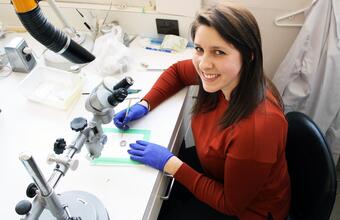
Emilee Lawrence always had an interest in history. That passion led her to apply to history and a few related subjects, including archaeology, when it came time to enroll in her undergraduate degree.
After selecting an archaeology program that featured a field school portion, the Burlington native was hooked. Once the degree was done, she proceeded to complete a masters in archaeology where she had the opportunity to work hands-on with materials in Jordan.
That hands-on exposure helped her refine her direction. She looked up graduate programs in art conservation and discovered that Queen’s had the only one of its kind in Canada.
“It was important to me to take a conservation program in Canada because I wanted to work on the material culture of Canada and, in particular, on Indigenous conservation projects,” she says.
She’s now getting that chance. In between internships in places like Turkey, and at institutions like the Royal Ontario Museum and the Canadian Conservation Institute, Emilee is working with Indigenous communities to assist conservation work at Writing-on-Stone/Áísínai’pi Provincial Park in Alberta.
“It’s not just about preserving or conserving the unstable rock art or removing graffiti and vandalism,” she notes. “It’s also about preserving its intangible qualities and values. This goes beyond my toolbox of adhesives and consolidants and looks at how can my expertise and research can support the knowledge that already exists and slow down the deterioration.”
The Art Conservation masters program offers a few different specializations depending on the types of materials you wish to focus on. For Emilee, the diversity of students that the art conservation discipline attracts provides many different learning opportunities and perspectives.
“It’s a small program, but my classmates all have varied backgrounds including programs like art history and studio art,” she says. “I learn something new – maybe even 10 new things – every day from the professors, from working with objects, and from my classmates.”
As Emilee prepares to complete her studies she is applying to fellowships in conservation, aiming to stay within the archaeological and ethnographic space. She looks forward to travelling, learning new things, and meeting new people – ideally with her fiancé along for the ride. The couple met during their studies and he is currently completing his PhD in archaeology.
For those considering the Art Conservation masters program, Emilee says the support for the program – as the only one of its kind in Canada – is very strong.
“You have lots of opportunities to work with professionals in the field and access organizations like the Canadian Conservation Institute,” she says. “The program has strong requirements and you need some experience beforehand, and you will need to be willing to work at it to find opportunities. Still, I love the program and am confident there’s a conservation opportunity for me out there.”
To learn more about the Art Conservation program, visit the School of Graduate Studies and Postdoctoral Affairs website.